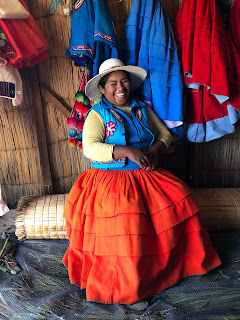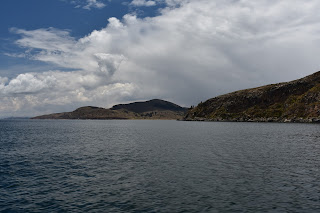December 14th:
We flew out of Cusco the next morning to Juliaca where we met our tour guide, Ivan. He took us to Puno (90 minute drive from Juliaca) and dropped us off at the Casa Andina Premium Hotel. Ivan told us that he would be back in the morning with a boat to take us on our tour of Lake Titicaca.
[More Andes Mountains!]
After unpacking we headed out to the terrace to have some tapas and check out our view of Lake Titicaca.
[Something I did not think about before coming on this trip was how much bottled water it would take to wash Theo's bottles and syringes. It's not safe for us foreigners to drink the tap water in South America and I didn't want Theo to get sick, so I washed all of his things with bottled water. These five bottles would last us one day and they are not cheap! I couldn't wait to get on the Zaandam where I could wash his bottles in the sink!]
December 15th:
After eating breakfast we met up with Ivan who lead us out of the hotel, over the railroad tracks, down a wooden pier, to a dock made of reeds.
We boarded our private boat and headed out into the lake. Ivan told us that we were going on a 30 minute boat ride to the floating islands where we would meet the Uru people.

According to oral traditions, the Uru people have been living in the area for thousands of years. When the Inca came to conquer them, they built these floating islands to get away from them.
Today, there are about 60 floating islands with ~1200 people living on them. They do keep a lot of their ancient traditions, but they have also embraced some modern technology (e.g. solar panels, TVs, beverages, etc.).
[We had to stop at this little hut and pay a toll]
We cruised around the islands until we found one to stop at.
We were welcomed to the island by the Uru people and the President gave a presentation on how the islands were built and maintained (Ivan translated for us).
First they go out and cut huge slabs of compact dirt.
Then they cut up the reeds
and lay them on top of each other.
Because the reeds rot they have to add more to the surface every few weeks. The islands can last about 30 years and then the locals have to move and build a new one.
They then invited us into their homes and to see the beautiful tapestries that they made.
[My parents bought this one]
[Josh and I bought this one]
[Homes]
After seeing the houses we went and saw how they make their reed boats. It takes a long time, BUT they fill the interior of the boat with empty plastic bottles to help them float and those bottles take up room, so it doesn't take as long to make as they use to.
[Josh in the observation tower]
They then took us on a ride on their reed boat to the Capital of the Uros Islands.
At the Capital, we got some hot chocolate and then our boat came and picked us up.
We then went on an hour ride to Taquile Island where the Taquileños live. During the ride Ivan told us about the history of the Taquileños. This culture dates back to Pre-Incan times and the islanders still live according to the traditions and beliefs of their ancestors.
Our Captain dropped us off on one side of the island and said he would pick us up after lunch on the other side.
We then walked across the island with Ivan while he told us more about the Taquileños and their colorful clothes.
[Ivan pushing Theo's stroller. I LOVE how helpful all of our tour guides were]
[Ivan paying our fees to the local law enforcement]
The pathway was completed for most of our walk, but towards the end the path disappeared and they guys had to carry Theo's stroller.
The locals are world renowned for their lovely outfits and incredible textiles. UNESCO has declared the textile art of Taquile Island as a "Masterpiece of the Oral and Intangible Heritage of Humanity."
We ended our walk at a restaurant which overlooks Lake Titicaca. We were served a delicious lunch consisting of quinoa soup and lake fish.
After lunch we went outside where the islanders performed a traditional dance for us.
They then invited us to join in. I volunteered to take pictures 🙂
We thanked the islanders for everything and then jumped back on the boat. It took almost two hours to get back to our hotel, but that was fine since the water was calm and we had plenty of room on our private boat to stretch out and take naps.
[Back through the reeds]
[Map of Lake Titicaca]
[Apparently if you look at the map upside down then it looks like a puma]
We got back to the hotel, thanked Ivan for a fun day, ate dinner at the hotel restaurant, and then went to bed.
December 16th:
The next morning, Ivan came and picked us up and took us back to Juliaca where we caught our flight to Lima.
[Overview of Puno with Lake Titicaca]
We then caught a flight from Lima to Santiago, Chile. Before we left Peru I bought some more chocolate!
We arrived in Santiago very late, went through Customs, and stayed the night at the airport hotel.
To be completely honest, I was very nervous about the Peruvian Land Adventure part of our trip. I knew we would be moving around a lot and I was worried about how Theo was going to handle it all. He did FANTASTIC! Besides throwing up his tube in Urubamba, we had no other issues with him. He never showed any signs of having altitude sickness or anything like that. Our tour guides were all VERY accommodating and would modify our itinerary if it would make Theo more comfortable. Being on private tours definitely helped a lot. I am so grateful we were able to explore Peru and learn more about these people and their (modern and ancient) cultures.
Now onto our 22-Day South American and Antarctic Cruise on board the Zaandam!






































































































